Tipping points (MANY FLASHCARDS)
1/152
There's no tags or description
Looks like no tags are added yet.
Name | Mastery | Learn | Test | Matching | Spaced |
|---|
No study sessions yet.
153 Terms
what is a tipping point
Characterized by a relatively small input or change that results in a disproportionately large outcome. Sometimes the change that is taking place is relatively small and reversible
when was the first idea proposed
Idea first popularized by Malcolm Gladwell.
Book talks about tipping points in social systems.
Example used of Hush Puppy shoes – these became suddenly very popular in the US in the 1990s, which Gladwell linked to ‘trendsetters’ creating a social epidemic.
Viral videos - similar concept. Some people have similar things where suddenly overnight people can have millions of views.
what is tipping points characterised by
a nonlinear response to gradual forcing
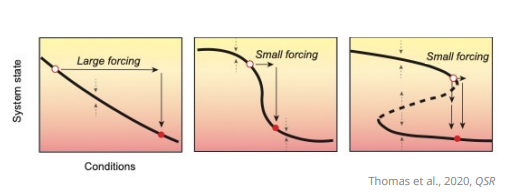
Describe the diagram
1) a big push along a flat ground – push it harder it goes faster- not a tipping point beacause it is not disproportional
2) a small force which causes a large change. Push a ball off a cliff – a tipping point because of a large change. Can be reverabele
3) a small thing that causes a large cahgne = cannot be reversed
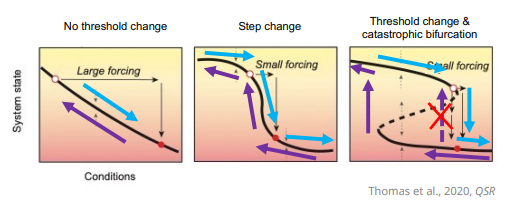
Describe the diagram
2) can go one way and reversable – takes the same forcing to go another way
3) different type = a represebtatuib that you cannot return to one point in the past once tou get to a certain point in the future
what is hystersis
the dependence of the state of a system on its history, i.e. a lag between input and output across a change in direction.
Takes a long time for something to revert back to the way it was but it is very quickly to melt
what is an example of hysteresis
Example: Ice sheets take a long time to build, but can melt very quickly.
what is a positive feedback
Positive feedback is a process which exacerbates the effects of a small disturbance. The effects of a perturbation on a system include an increase in the magnitude of the perturbation. A produces more of B which in turn produces more of A.
what is a regime shift
a substantial reorganization of a complex system with prolonged consequences, as the system moves from one functioning state to another across poorly understood thresholds (high to low resilience)
what is critical transition
catastrophic fold bifurcations
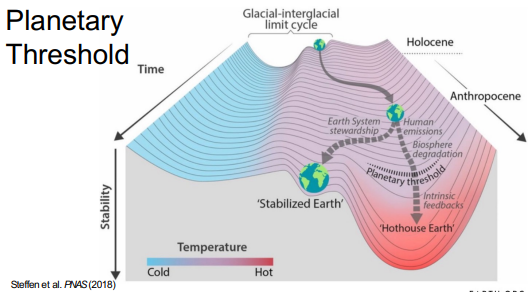
what is the planetary threshold
The resilience of a system, physical, ecological or social, refers to its tendency to avoid such tipping points and maintains stability. A tipping point is the minimum amount of change within a system that will destabilize it, causing it to reach a new equilibrium or stable state.
Hence understanding system resilience (increasing/decreasing) is important for predicting and potentially mitigating tipping points.
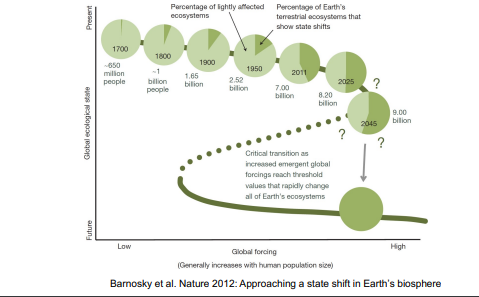
what are the main question to ask about tipping points
What is pushing the system towards loss of resilience?
Is it a single driver, or more likely multiple drivers?
Do they operate on a relatively fast or slow basis?
Consider a landscape system (e.g. food producing farm) – what are the important slow and fast drivers?
what equals small variance
high resilience, high recovery rate, low autocorrelation, small permutations
what equals high variance
low resilience, low recovery rate, high auto correlation, small perturbations
what does high resilience mean in terms of recovery
means fast recovery
what does low resilience mean in terms of recovery
slow recovery
what is critical slowing down
slower recovery rate as tipping point approaches
whereby the system takes longer to recover from small perturbations.
what are the early warning signals
pattern of fluctuations: autocorrelation, variance, skewness
Can bifunctional tipping be predicted?
Early warning signals can be mathematically detected by looking at the pattern of fluctuations in the short-term trends of the data before the transition takes place.
what are three things to measure to see if we’re going to have an abrupt change. explain what are they?
Autocorrelation: “The system becomes more and more like its past state: lag-1 correlation of the dataset within itself”
Variance: “The system becomes increasingly more variant, goes further from its point of equilibrium…”
Skewness: “The basin of attraction becomes deformed, and the system preferentially goes to one side of the basin rather than the other…” - see the asymetry as skewness
what are the main things involved in tipping points analysis
1) Data selection and pre-processing
Data selected prior to tipping point
Data must be detrended
2) The measurement of indicators of tipping
Over a 10-50% sliding window length
Kendall t provides quantitative measure of trend
3) Significance and sensitivity testing
What evidence exists in Nature for Early Warning Signals?
Much of the initial work on lake sediments (fluid system)
Focus on rising variance for warning before tipping point – Means the variability of the system increases ahead of the tip
Did we see other changes?
what is an example of tipping point early warning systems
low eutrophication water state to clear water. it went green suddenly
Tipping point happened at ~2002 AD, when the continuous algal blooming happened in Erhai
Rising variance could be considered as a leading indicator for tipping point in Erhai:
predicted 20 years before regime shift
Instrumental data: strong evidence for external drivers, unlikely internal noise generated by internal changes
Rising variance represents interaction of multiple external drivers – magnifies system responses & induces flickering
what are the main problems with the Erhai, Yunnan provence tipping point?
Conjunction fallacy (Spears et al. 2017) – alternate steady states/regime shifts are assumed - not rigorously tested. But do we have the right model?
Generally, lakes in restoration show gradual improvements as nutrient loadings are reduced with no tipping point back to the original state (Jeppesen - Danish lakes). Why?
Identifying early warning signals fails in many statistical studies of monitored (too short?) and reconstructed (unequal time intervals?) time series of aquatic ecosystems. Are there better approaches?
what are other applications of critical slowing down
ecology
medical
geohazards
engineering
what were 4 of the main types of megafauna that went extinct
giant deer
giant ground sloth
woolly mammoth
giant wombat
when did humans move out of africa?
around 200,000 years ago
how did humans enter north america
via a land bridge of ice. this caused problems later
why is australia a conundrum
Humans managed to get into Australia quite quickly after africa exit. There was never a land bridge. Humans HAD to travel across the sea to africa. Managed to cross the sea before they got to other places. Some of the oldest dated sites is about 65, 000 years ago. Only moved out of africa around 70,000 years ago.
what ws the last place that humans migrated too
around 2-3,000 years ago or some research pushes it to 5,000 years ago. Still geologically recent
why did humans move out of africa
Resource Availability
Climate change
Population Pressure – we don’t know how dense the area plane was.
Innovation and Technology – may have been some innovations for tools – lead them to carry tools/ ability to carry water.
Social and Cultural Factors – sometimes there isn't a tangeable reason. Someone was kicked out of their campfire and started to wonder, they were curious.
Hominin biology
Brain thermoregulation? - lookig how the brain is infulaenced by temp (quite controvercial)
Coevolved zoonotic diseases
what factors could help to explain the geographic pattern of migration?
They were following the coastline – there is always some type of water to drink. Didn’t go west because there is a big ocean so couldn’t cross paciffic.
Could possibly follow the sun – why they went east.
The mountains are difficult to traverse. Across from Europe into Russia it is hard to do so because of huge mountain ranges.
Followed rivers as well – likely that early humans wouldve followed rivers.
what was the final stage of human migration and why
Islands because they didn’t have the technology to cross the sea. We needed boats that coulve traveled over long distances.
It couldve been possible to island hop all the way to australia by standing on the top of a hill.
The pacific was much later as it was unkown where they would be.
where didthe neandertales and homo erectus first migrate too
Neanderthales and homerectus were in eurpoe and in china and india when homosapians first emerged out of Africa.
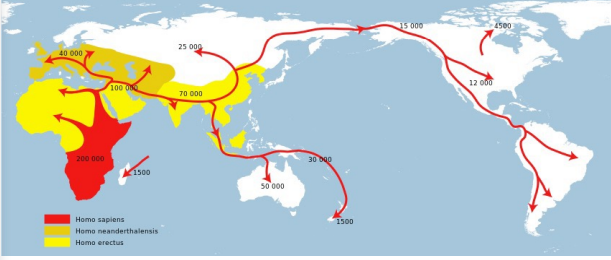
what was the climate doing at the time when humans moved?
Climate has changed quite dramatically. The Quaternary is characteristic of cuclicity of orbit around our sun. Milankovitch. The early Quaternary was characterised by these cycles. More ice and less ice. The late quaternary were characterised by the 100 kyr cycle.
This is the last glacial cycle (las 150,000 years). Temps were silimar to what they are today. Temps decreased until the last glacial maxium. Then have the holococene after the jump.
This is the same period of time. But from greenland. It changed in different ways for different places. Humans didn’t really get to the ice places but get the best climate records for here. So need to extrapolate data.
These are big climatic events in greenland in the last ice age – big swings in temp.
why wasnt it just about temperature that caused humans to migrate
Paleoclimate history of northeast Africa, the gateway to migration, is relatively unknown.
Data suggest that warm and wet conditions from 120,000 to 90,000 yr ago could have facilitated early waves of human migration.
However, the primary ‘out-of-Africa’ event, (ca. 65-55 ka), occurred during a cold and dry time. This complicates the climate-migration relationship, suggesting that both "push" and "pull" factors may have prompted Homo sapiens to colonize Eurasia.
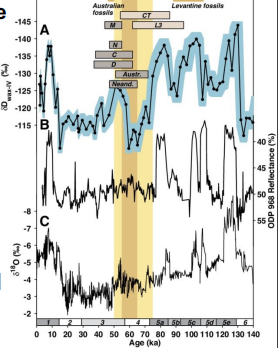
what does this graph show
Some marine cores of the coast of affrica.
Up is wet, down is dry.
C= up is warm and down is cold.
Humans exited out of africa in the yellow band. It was a lot dryer. Prompted people to move for food and water. people moved in cold and wet period that had just happened.
Push and pull factios: climate can trigger people to move if they thik something is better.
when and why did mass extinctions occur
“Recognition of extinction” important part of the development of ecology and evolutionary theory:
Alfred Russel Wallace: “we live in a zoologically impoverished world, from which all the hugest, and fiercest, and strangest forms have recently disappeared…”
Georges Cuvier: studies of mammoth and mastodon in the early nineteenth century led to extinction being recognised as a real phenomenon
Charles Darwin: from the cliffs of the Rio de La Plate Darwin dug out the remains of giant sloths – these recently extinct South American megafauna formed a large part of the basis for his ideas on evolution by natural selection (along with other observations…)
Permafrost mammoths – economically important source of ivory
Why are Large animals more vulnerable
Exist at lower population densities
Intrinsic rate of population increase declines with increasing body mass
Likelihood of extinction was higher for groups with lower reproductive rates, regardless of body size
Disproportionately exploited by humans
why would species go extinct
Their habitat is lost and they can’t find refugia (or they don’t exist)
Breeding populations are isolated – may cause speciation (new species replace old)
They can’t evolve fast enough as habitats are lost
From above follows that the less adaptable a species is (the narrower its ecological range) the more likely it is to go extinct I.e. generalists don’t go extinct?
what happened in theLate Quaternary
(a) The proportion of extinct large mammal species (more than or equal to 10 kg) in each country during the last 132 000 years, only counting extinctions earlier than 1000 years BP.
(b) The cumulative number of extinct large mammal species occurring in each country.
(c) Hominin palaeobiogeography
(d) Mean anomaly in mean annual temperature between the LGM and today.
(e) Mean velocity in annual precipitation between the LGM and today. Countries shaded in dark grey were excluded from analyses.
What occured in the Planetary Tipping Points and Safe Operating Spaces
Late Quaternary extinctions (large and small species) can be seen as either a relatively minor episode or just the beginning of a major mass extinction—the so-called ‘Sixth Extinction’—that is in progress at the present day and shows every indication of accelerating into the future
what is the evidence of the Late Quaternary extinctions
Radiocarbon dating directly of megafaunal material, namely bones, teeth, antlers and, more rarely, various soft tissues and dung.
Extinction dynamics from ancient DNA (aDNA)
E.g. changes in genetic diversity (declines), but some species experienced genetic bottlenecks and survived
Diets and community structure from stable isotopes
Early work that was looking at this work was thought to be over 50,000 years but couldn’t see because carbon dating doesn’t go past 50,000 years.
You can’t ever not find a fossil – just moves the extinction rate to be younger. Uses raidoative carbon dating and ancient dna to help figure out when extinctions were.
There were a set of climatic bottleneck events that narrowed down the species- these are very helpful to help see species.
what are the 3 main theories of what killed the megafauna?
Prehistoric Overkill theory
Environmental Change theory
Competition for resources
what is the Prehistoric Overkill theory
Global spread of humans exterminated megafauna
That humans killed the megafauna
Problems with this approach (summarized by Stuart, 2015):
(a) How could humans in low population densities and with relatively simple technologies have exterminated so many varied large animals and over their entire geographical ranges?
(b) In northern Eurasia, most, or all, extinctions occurred many millennia after the appearance of modern humans.
(c) Late Pleistocene extinctions, especially in the Americas, affected a number of smaller mammalian and avian species that are unlikely to have featured significantly in the human diet.
(d) Many extinct carnivores were also very unlikely to have been extensively hunted.
(e) For most of the subsequent Holocene period, very few megafaunal species on the continents have disappeared, although faced with very much higher human populations.
(f) Many species which are known to have been extensively hunted, such as reindeer and horse in northern Eurasia, survive to the present day.
what is the Environmental Change theory
Replacement of vast areas of open ‘mammoth steppe’ (grasses and herbs) by forests as climate changed towards start of Holocene, i.e. loss of habitat due to climate change
But these changes have repeated for last c. 800,000 years
Why did survivors (e.g. reindeer, musk ox) find new suitable habitats?
Did topographic barriers play a role for extinct species? Or remaining areas too small/fragmented?
what is the Competition for resources theory
Direct competition for limited resources during periods of pronounced environmental stress?
But why clustered around 40 ka? Esp in Australia.
Geomagnetic excursion (Cooper et al. 2021, Science) has been proposed as to what happened at a solar maximum.
geomagnetic field minima at ~42 ka caused substantial changes in atmospheric ozone concentration and circulation, driving synchronous global climate shifts that caused major environmental changes and extinction events – could’ve driven major climatic shifts
what mass extinctions occurred in eurasia
18 out of 49 species (>45kg) went extinct (37%)
Note many survivors, including: Ursus maritimus (polar bear), Ursus arctos (brown bear), Sus scrofa (wild boar), Alces alces (Eurasia elk or moose), Rangifer tarandus (reindeer or caribou), Ovis canadensis (bighorn sheep), Capra pyrenaica (Spanish ibex), Bison bonasus (European bison), and many deer species (Cervus)
what is the mammoth
(Mammuthus primigenius)
Youngest dates elsewhere in Europe 14500-14000 cal yr BP
Hunters in Europe had co-existed with mammoths for 1000s of years
Dates suggest mammoths could not cope as tundra grasslands became forested in warm Alleröd/Greenland interdstadial event 1
what is the giant deer
Megaceros giganteus
Dimensions: 2.1m at shoulder 3.6m antler spread!
In Ireland goes extinct in the lateglacial (c.12,700-10,000 Younger Dryas ) – Homo sapiens are not present
On the Isle of man: survival into the very early Holocene and we see dwarfism
Survived until 7,700 BP in Urals
what mass extinctions occurred in north america
38 out of 55 species (>45kg) went extinct (69%)
Many smaller species also went extinct during the Late Pleistocene (including the ∼2-kg rabbit Aztlanolagus and the ∼11-kg pronghorn Capromeryx)
what is the La Brea Tar Pits
Remarkable pits of bubbling tar within Los Angeles have acted for trap for animals, plants and one known human (c. 9000 BP) for the last 38 thousand years.
From the pits we have a comprehensive species list includes extinct species such as American lion, several species of mammoth, extinct bison, bear, sabre-toothed cat, extinct horse…as well as many species alive today
extinction logs
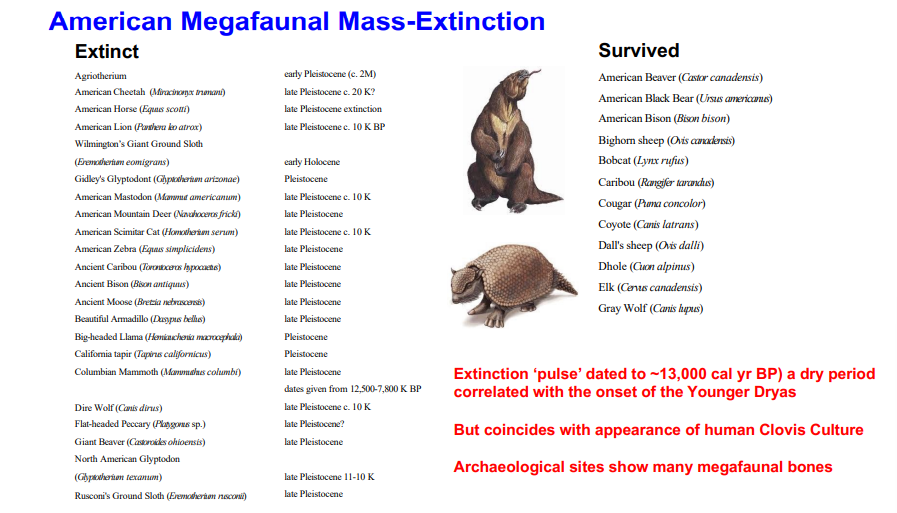
what are the clovis culture
Many sites exhibit ‘black mats’ in alluvial sequences which are mollic (organic & base-rich grassland soils) palaeosols and appear to be correlated with the Younger Dryas in Europe.
A group of humans that have a specific way of living. Some have cuffs on which indicate that there were some direct interactions between the megafauna and homosapians
Clovis ‘big game’ hunters first appeared 13.4k cal BP
Expanded quickly across North America
Some evidence for kill sites
what are the north america arguments against overkill
Scale. Too few humans (initially), and too many animals
Kills sites only provide evidence for 5 genera (no evidence any of the other 33 genera were preyed upon)
More evidence now suggesting many of the 33 genera extinctions were staggered
New evidence suggesting humans arrived c. 1000 years pre-Clovis (but no pre-Clovis kill/scavenging sites)
Many species found in kill sites have survived – example of bison
Many other species became extinct that were not hunted (e.g. birds, snakes, spruce trees)
Survivors experienced range shifts and changes in abundance, i.e. they were impacted
Climate: North vs South America
Extinction chronology of Pleistocene megafauna in southern Patagonia (9000 to 18,000 years ago), shown against West Antarctic Ice Sheet Divide ice d18O record (bottom) and the timing of Antarctic Cold Reversal chronozone.
Compared against North American climate (different) and summed probability (C-14 dates) extinctions (grey shading)
Authors conclude:
The increased resolution provided by the Patagonian material reveals that the sequence of climate and extinction events in North and South America were temporally inverted, but in both cases, megafaunal extinctions did not occur until human presence and climate warming coincided.
Overall, metapopulation processes involving subpopulation connectivity on a continental scale appear to have been critical for megafaunal species survival of both climate change and human impacts.
Suggests that only when humans and climate situations collided that extinction of fauna occurred.
what is evidence from south america
Local species richness map of extinct large mammals and the calculated potential distribution of Fishtail projectile points (FPP), together with the temporal change in the density of both variables for all of South America and the climatic changes.
Striped areas in the map represent the potential distribution of FPP. Local species richness of extinct large mammals varies on the map from 1 (light green) to >5 (dark green).
Relative climatic changes (temporal temperature curves) are indicated in beige (0–30° S) and grey (>40° S), and the ACR (Antarctic Cold Reversal) period in dark beige (inset)
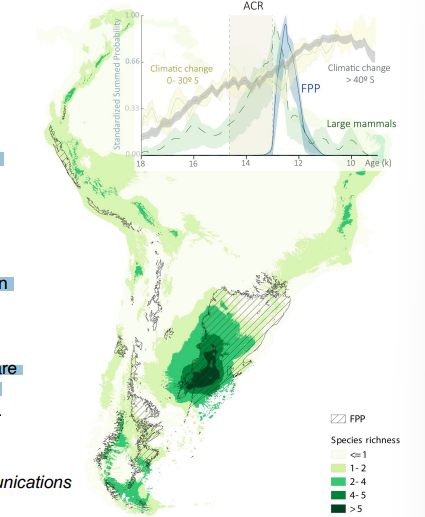
what mass extinctions occurred in australia
28 genera and 55 species went extinct
Examples include:
Thylacoleo carnifex (‘marsupial lion’)
Diprotodon optatum (up to c.2800 kg)
New dating (sequences) shows wide scale ecosystem changes appear independent of megafaunal change and human arrival. Humans implicated
Tipping points risks for contemporary Megafauna?
Amir et al. 2022. Science Advances Found that there were no consistent size- or guild-related trends, no two tropical forests had identical assemblages, and the abundance of four species showed positive relationships with forest degradation and humans.
Results suggest that the region’s megafauna assemblages are the product of a convoluted geoclimatic legacy interacting with modern disturbances and that some megafauna may persist in degraded tropical forests near settlements with sufficient poaching controls.
Overall Humans or climate?
Disease seems unlikely – though can’t be discounted.
Human impact seems to be a factor - but perhaps to varying degrees. Very strong impact on islands – e.g. NZ, Mediterranean. But large continental areas..?
Direct overkill, competition for resources, an extra stress in the presence of rapid climate change…
Few examples of remains with weapons. Difficult to explain extinctions in animals (NA sloth) that have very large continental ranges.
And yet where hominins have lived longest, Africa, the extinctions were low.
“How can we expect the fossil record to yield unambiguous interpretations of extinctions that happened 10,000 to 30,000 years ago, when we are often unable to understand declines of species being studied in the field today?” Jared Diamond
Cant even understand right now what is happening so how on earth are we supposed to understand what happened in the past. Maybe its time to start to focus of the what the heck is happening now!!! Then make predictions of what did happen in the past.
what types of food did early humans eat
Our ancestors’ diets were really variable. They were hunter-gatherers, so they were hunting and gathering whatever foods were around in the local environment.
Humans are strategic about what foods they go after, but they can target only the foods that are there. So there was a lot of variation in what hunter-gathers ate depending on location and time of year.
They hunted wild animals and gathered wild fruits and roots. In fact, up to two thirds of their diet was likely plant based - particularly fruits, roots and greenery.
what were their food types dependent on?
where they were living
in warmer climates - ate more meat
near the coast - ate more fish
what is so important about the knowledge that they ate fish?
Implies that this is the hominins were using stone tools.
how many years ago was agriculture developed
around 10,000 years ago
what is the definition of agriculture
practice of cultivating the soil, growing crops, or raising livestock for human use.
This was developed independently in several regions around the world.
So what were the drivers of this radical change in diet and lifestyle?So what were the drivers of this radical change in diet and lifestyle?
probably climate
what was suignificant abour the climate 10,000 years ago
The difference of global temperature to present day – 1950. Increases as we got to the holococene.
A lot of proxis only grow in summer time e,g, summer rings. If you only use proxis that occur in summer time then your data is bias.
The blue line takes out the slighly increase and a very moderate warming though the holococene.
How stable was the Early Holocene climate?
Early Holocene temperatures: chironomid-inferred summer temperatures (CI-T) Hawes Water, Cumbria
Not very stable!
Cool oscillations at 11300, 10700, 10400, 9300 and 8300 b2K throughout the EHWP – Early Holocene Warm Period
The holococene is known for a relativly stable climate.
how did vegetation vary in the holocene?
Soils developing in catchments, enhanced vegetation growth
Better resources?
Mesolithic culture Hunter-gatherer-fishers dominated in the UK
The vegetation changed a lot over the last 14, 000 years. There was a very dry period and then in the holococen that all changed dramatically.
More wood for humans.
what was different about the sahara 10,000 years ago
it was much wetter
what casued the rising sea leavel in the holocene?
Melting ice – eustatic sea levels (rise)
Rebound (ice caps) and submergence (ice periphery) – isostatic changes (land relative to ocean)
As ice caps melt the land rises up due to the weight on the land shrinks.
The two may work for or against each other
Eustatic sea level rising by ~60 m from start of Holocene until at least 7000 cal yr BP – dominates globally (sea rises not land)
Major significance for coastal settlements in the early Holocene – happened all over the world.
what was one of the first human tipping points
The Neolithic Revolution or Neolithic Demographic Transition, sometimes called the Agricultural Revolution, was the wide-scale transition of many human cultures from a lifestyle of hunting and gathering to one of plant and animal domestication, agriculture and settlement, allowing the ability to support an increasingly large population….
what 3 major centers dud farming start in?
China, Southwest Asia, Mesoamerica.
How were plants domesticated from the wild?
Metabolic Changes Concurrent with the Domestication and Improvement of Major Cereals
Selective breeding by early human populations. Likely collection and cultivation of wild plant species for food.
Desirable traits (larger seeds, abundant yields) recognised and these plants deliberately propagated.
Repeated cycles of this led to genetic changes.
what is the fertile crescent?
in the middle east (where a lot of plants domesticated)
what plant did china domesticate
rice
what plant did mesoamerica domesticate
maize and corn (was considered god)
what are the morphological differences between the ears of wild and domestic wheat (einkorn).
The ears of wild einkorn shatter at maturity,
each spikelet leaving the stem as a dispersing propagule and
having at its base a smooth abscission scar.
By contrast, the ears of domesticated einkorn are nonshattering and remain intact after ripening, threshing being needed to detach the spikelets, which results in
a jagged break at the base of each one.
how did agriculture spread across the world?
mainly were concentrated around main rivers that then spread mainly west.
In most parts of the world Neolithic agriculture is recognised by the sudden appearance of exotic species (domesticates). But is the package carried by/with people or as a diffusion of ideas? Are both models gradual transition – e.g. is the tipping point only seen in local archaeology and/or environmental change?
what are the two theorys as to how farming spread?
Demic model (‘package’ model)
Cultural-diffusionist model (Mesolithicneolithic transition model)
what is the Cultural-diffusionist model (Mesolithicneolithic transition model)
The Mesolithic-Neolithic transition model suggests that the spread of agriculture occurred through the gradual diffusion of farming practices and technologies from their places of origin to neighbouring regions.
It highlights the role of cultural exchange, trade networks, and interactions between Mesolithic hunter-gatherer groups and Neolithic farming communities in the adoption of agricultural practices. - hunter-gatherer ancestry persisted?
With the revolution in ancient DNA in the last few years, we can address questions regarding the demic model vs. cultural-diffusionist model. has only been used in the last few years.
DNA evidence shows that as new farmers were moving through Europe, they were mixing with the local hunter-gatherers. As this Neolithic population moved west, we can track cumulatively increasing levels of the local hunter-gatherer signatures in the genetics - this wasn't just one population wiping the other out. Instead, they were mixing.
However, in the Baltic regions, there is a high degree of genetic continuity from the Mesolithic to the Neolithic, suggesting instead that these people probably acquired knowledge of farming and ceramics by sharing cultures and ideas — rather than genes — with outside communities.
what is the Demic model (‘package’ model)
The Demic model proposes that the spread of agriculture was primarily driven by the migration of farming populations ("demic diffusion"). It suggests that Neolithic farmers migrated from their places of origin, bringing with them the package of domesticated plants and animals that characterised the Neolithic way of life. - genetic continuity?
Driven by the migration of people. As they moved from their point of origin they brought their package. This indicaates that there was a mixing – a genetic continuity from the mesolithic to neolithic. Genetics continue to mdern day.
What did the spread of agriculture lead to?
Trade – people were able to trade to communities. Small trade works between comunities
Increasingly stationary lifestyle. If you find a fertile land then you are going to stay there and a more sedimentary lifestyle. Lead to an increase in small settlements. Hunter gatherers needed to move around with the food.
Population increase
Deforestation in some places
Lead to a difference and advance in culture expansion (crafts and pottery – so much more archilology) religion increased (mayans in particular
what happened at Star Carr (from ~9000 Cal yr BP)
Large Mesolithic settlement site in ancient Lake Flixton swamps – probably not continuous more summer/seasonal.
Noted artefacts – flint tools, barbed points for hunting on North York Moors(?) and headgear made from deer skulls with antlers suggesting social complexity and rituals.
Food web – aquatic plants, fish
Herbivores - beaver, red deer, roe deer, elk, aurochs (wild cattle), wild boar, hare
Carnivores such as wolf, lynx, bear, fox, pine marten, badger and hedgehog
what can be used to help see vegetation types
Carbon 13 is linked to vegetation. When you eat vegetation it loges in your teeth and bones. Can measure the levels of carbon in your bones
where do origins of languages come from?
the main farming centres
What do simulation models tell us about farming?
Simulation of farming at Neolithic transition from simple rules of plant productivity, population growth and geographical links predicts Eurasian and Chinese centres well – at roughly the right dates!
Local population pressure – due to immigration or climate change – is NOT a prime mover of agricultural development.
More likely steady innovation and competition between different ways of life.
A combination of innovation and evolutionary cultural spread?
Manages to predict wehre the centres of agriculture developed.
Implications for the start of farming: an early Anthropocene?
Can changing land use c. 8000+ years ago alter atmospheric gas concentrations?
Is the scale of change big enough?
How do we know what is ‘natural’
A couple of events where it could be argued where humans have had a fundamental impact on the planet to be the beginning of the Anthropocene.
what is the The (Ruddiman) theory –
Schematic summary of two views of Holocene climate.
Natural hypotheses regard the nearly stable observed climate trend as natural in origin.
But the anthropogenic hypothesis claims that climate would have naturally cooled and passed the threshold for early glacial inception if anthropogenic greenhouse gas emissions had not offset most of a natural cooling.
Without greenhouse gasses the global temp would decrease quite substantially. Natural cooling was reveres by the anthropogenic greenhouse affect caused by agriculture
did human farming lead to a change in the envrioment?
Comparison of Holocene trends (red) of CO 2 (A) and CH 4 (B) to averaged values (in blue) for previous interglaciations, from Ruddiman et al. (2016). Based on Dome C data in Monnin et al. (2001) and many papers by EPICA Community Members (2004)
Rapid increase temp and gradual cool down. There is a divergence. Different than the last 800,000 years.
what is the methane evidence for farming
Map showing the reconstructed regional arrival time for rice in millennia BC, based on a preliminary GIS spatial model.
Estimated that CH 4 emissions from northern paddies accounted for 70% of the increase in atmospheric CH4 recorded in ice cores during that interval.
what is the carbon dioxide evidence for farming?
Population growth was rapid enough from c. 7000 BP, and land use clearance was extensive by c. 6000 BP, and had ‘transformed the planet’ by c. 3000 BP
Independent estimates of pre-industrial carbon emissions due to deforestation cluster in the range of 310-343 Gt, equivalent to a 21-24 ppm increase of atmospheric CO2 after equilibration with the deep ocean. With peat/coal burning, gets to 24 ppm, 60% of the 40 ppm proposed.
what are the 5 centres of emergence of urbanism
Mesopotamia
Egypt
Indus (Harappan) Region
Yellow River China
Mesomerica/SW north America
these are non suprisingly centred around rivers!
what is the size- complexity rule
As interpersonal contacts increase so does chance of disputes so we get leaders/administrators and then new structures to help them mediate/control
There's a linear relationship where the smaller a particular part of a brain the smaller the social group is. As we evolved it allowed for larger group sizes to exist. There is a lot of in fighting because you kill off the larger numbers.
what are the main theorys surrounding the emergence of urbanism
Neo-evolutionism
Geographical
Hydraulic theory – how we use water sources and how we exploit them to allow these urban centres to develop
Power relations – how to maintain large group sizes
Social evolutionary theory
Ideologies of states – if you have certain ideologies that allow you to develop.
what is urbanism?
interactions between people in towns and cities (about people rather than places)
what is organic growth of cities
cities that evolved in an unplanned process e.g. Mesopotamia
what is planned growth of cities?
cities that were laid out in a predetermined way based on some geometrical design or of regularized land holdings. Planned lay out of streets could signify the presence of central control. (not just in modern times – happened in the past history as well)
Top down flow – some kind of central flow who regylated the building. Doesn’t happen without planning.
But in long-lived cities the internal structure – never static – evolves – some cities – changed from organic to planned and vice versa eg. London - planned to organic – then after Great Fire planned again.
what are intra-muros
(within walled area) and extra-muros (outside walls) – growth of support areas outside walled cities – can become larger than the walled area
what is the first urbanised area
Early settlement Ur grows into first city Uruk. At its peak ~5800 cal yr BP 50,000- 80,000 residents.
Other cities in region (e.g. Kish, Lagash), but rarely unified, generally separate city states but did identify with the region of Mesopotamia)